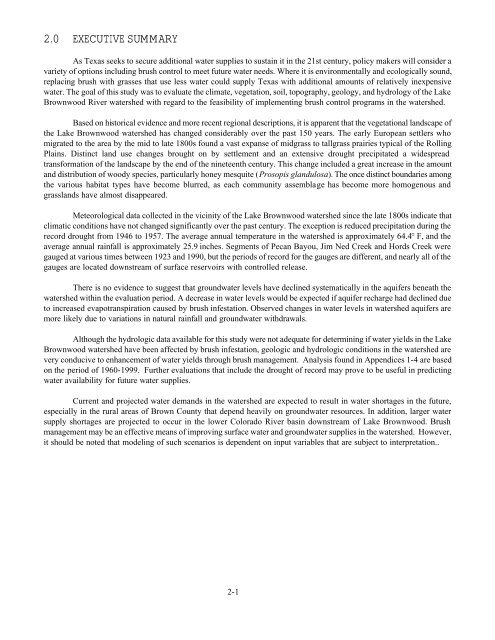Lake Brownwood Watershed - Texas State Soil and Water ...
Lake Brownwood Watershed - Texas State Soil and Water ...
Lake Brownwood Watershed - Texas State Soil and Water ...
Create successful ePaper yourself
Turn your PDF publications into a flip-book with our unique Google optimized e-Paper software.
2.0 EXECUTIVE SUMMARY<br />
As <strong>Texas</strong> seeks to secure additional water supplies to sustain it in the 21st century, policy makers will consider a<br />
variety of options including brush control to meet future water needs. Where it is environmentally <strong>and</strong> ecologically sound,<br />
replacing brush with grasses that use less water could supply <strong>Texas</strong> with additional amounts of relatively inexpensive<br />
water. The goal of this study was to evaluate the climate, vegetation, soil, topography, geology, <strong>and</strong> hydrology of the <strong>Lake</strong><br />
<strong>Brownwood</strong> River watershed with regard to the feasibility of implementing brush control programs in the watershed.<br />
Based on historical evidence <strong>and</strong> more recent regional descriptions, it is apparent that the vegetational l<strong>and</strong>scape of<br />
the <strong>Lake</strong> <strong>Brownwood</strong> watershed has changed considerably over the past 150 years. The early European settlers who<br />
migrated to the area by the mid to late 1800s found a vast expanse of midgrass to tallgrass prairies typical of the Rolling<br />
Plains. Distinct l<strong>and</strong> use changes brought on by settlement <strong>and</strong> an extensive drought precipitated a widespread<br />
transformation of the l<strong>and</strong>scape by the end of the nineteenth century. This change included a great increase in the amount<br />
<strong>and</strong> distribution of woody species, particularly honey mesquite (Prosopis gl<strong>and</strong>ulosa). The once distinct boundaries among<br />
the various habitat types have become blurred, as each community assemblage has become more homogenous <strong>and</strong><br />
grassl<strong>and</strong>s have almost disappeared.<br />
Meteorological data collected in the vicinity of the <strong>Lake</strong> <strong>Brownwood</strong> watershed since the late 1800s indicate that<br />
climatic conditions have not changed significantly over the past century. The exception is reduced precipitation during the<br />
record drought from 1946 to 1957. The average annual temperature in the watershed is approximately 64.4° F, <strong>and</strong> the<br />
average annual rainfall is approximately 25.9 inches. Segments of Pecan Bayou, Jim Ned Creek <strong>and</strong> Hords Creek were<br />
gauged at various times between 1923 <strong>and</strong> 1990, but the periods of record for the gauges are different, <strong>and</strong> nearly all of the<br />
gauges are located downstream of surface reservoirs with controlled release.<br />
There is no evidence to suggest that groundwater levels have declined systematically in the aquifers beneath the<br />
watershed within the evaluation period. A decrease in water levels would be expected if aquifer recharge had declined due<br />
to increased evapotranspiration caused by brush infestation. Observed changes in water levels in watershed aquifers are<br />
more likely due to variations in natural rainfall <strong>and</strong> groundwater withdrawals.<br />
Although the hydrologic data available for this study were not adequate for determining if water yields in the <strong>Lake</strong><br />
<strong>Brownwood</strong> watershed have been affected by brush infestation, geologic <strong>and</strong> hydrologic conditions in the watershed are<br />
very conducive to enhancement of water yields through brush management. Analysis found in Appendices 1-4 are based<br />
on the period of 1960-1999. Further evaluations that include the drought of record may prove to be useful in predicting<br />
water availability for future water supplies.<br />
Current <strong>and</strong> projected water dem<strong>and</strong>s in the watershed are expected to result in water shortages in the future,<br />
especially in the rural areas of Brown County that depend heavily on groundwater resources. In addition, larger water<br />
supply shortages are projected to occur in the lower Colorado River basin downstream of <strong>Lake</strong> <strong>Brownwood</strong>. Brush<br />
management may be an effective means of improving surface water <strong>and</strong> groundwater supplies in the watershed. However,<br />
it should be noted that modeling of such scenarios is dependent on input variables that are subject to interpretation..<br />
2-1



